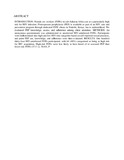Barriers to the uptake of postexposure prophylaxis among Nairobi-based female sex workers

View/
Date
2015-09Author
Olsthoorn, AV
Sivachandran, N
Bogoch, I
Kwantampora, J
Kimani, M
Kimani, J,
Kaul, R
Type
enLanguage
enMetadata
Show full item recordAbstract
INTRODUCTION:
Female sex workers (FSWs) in sub-Saharan Africa are at a particularly high risk for HIV infection. Postexposure prophylaxis (PEP) is available as part of an HIV care and prevention program through dedicated FSW clinics in Nairobi, Kenya, but is underutilized. We evaluated PEP knowledge, access, and adherence among clinic attendees.
METHODS:
An anonymous questionnaire was administered to unselected HIV-uninfected FSWs. Participants were dichotomized into high and low HIV risk categories based on self-reported sexual practices, and prior PEP use, knowledge, and adherence were then evaluated.
RESULTS:
One hundred thirty-four HIV-uninfected FSWs participated, with 64 (48%) categorized as being at high risk for HIV acquisition. High-risk FSWs were less likely to have heard of or accessed PEP than lower risk FSWs (37.5 vs. 58.6%, P = 0.014; and 21.9 vs. 40.6%, P = 0.019, respectively). Among higher risk FSWs, those who had accessed PEP were more likely to report treatment for a genital infection (71.4 vs. 42.0%, P = 0.049) or sex with an HIV-infected man (62.5 vs. 37.5%, P = 0.042) during the last 6 months. However, only 35.7% of high-risk women accessing PEP completed a full course of treatment, and noncompleters were more likely to report prior unprotected sex with an HIV-infected man (P = 0.023).
CONCLUSION:
Despite freely available PEP for Nairobi-based FSWs, women at highest risk were less likely to have heard of PEP, access PEP, or complete the full course of therapy once initiated. Program delivery needs to be improved to ensure that FSW most at risk are able to benefit from this resource.
Citation
AIDS. 2015 Sep 13. [Epub ahead of print]Publisher
University of Nairobi
Collections
- Faculty of Health Sciences (FHS) [10415]
